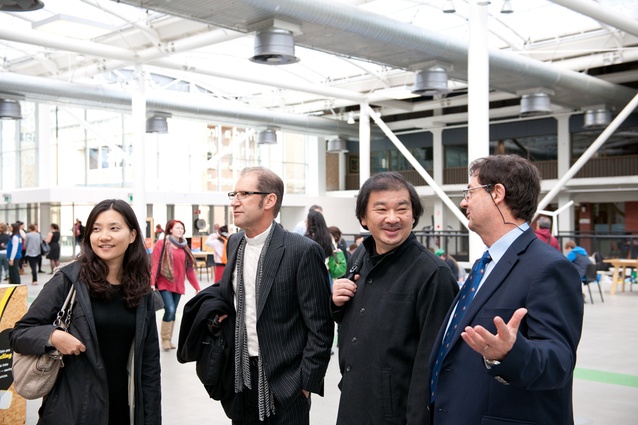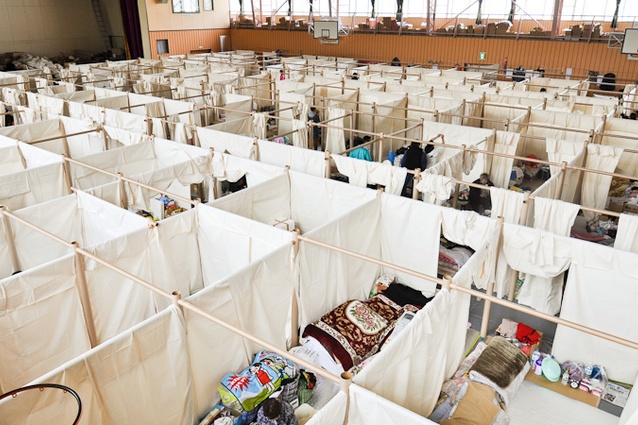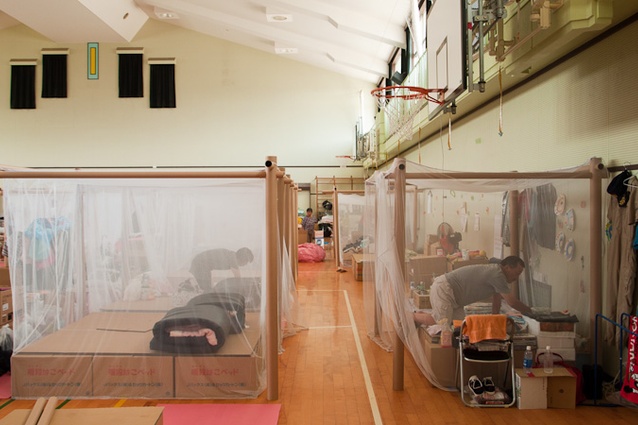Paper giant: Shigeru Ban in Adelaide
On 30 August 2012, Shigeru Ban made a flying visit to Adelaide to give two talks and raise funds for earthquake-stricken Christchurch. University of Adelaide lecturer Francesco Bonato and Masters student Jack Saunders give their impressions of this rare encounter.
Francesco Bonato
It’s not every day a star of architecture visits Adelaide. Like rock stars, it seems, architects prefer the direct flight between the east coast and Perth, missing Adelaide altogether. It came as quite a surprise, then, when the University of Adelaide architecture timetable was up-ended for a day in August and my pod of Masters students disappeared to take in a sudden, but welcome visit by Shigeru Ban.
If, like me, you are a fan of John Hejduk, of the Cooper Union School of Architecture and of the famous New York Five (Charles Gwathemy, Michael Graves, Peter Eisenman and Richard Meier), a visit by Shigeru Ban is like having a member of architectural royalty in your midst. Hejduk was a master of ‘paper’ architecture, who built very little during his career, and Ban quipped during his visit that he was simply continuing his teacher’s tradition.
Of course, Ban is most famous not for paper architecture, but for his use of paper in architecture, particularly recycled cardboard. For Ban, the use of recycled cardboard is not to serve some pious ecological imperative, although he acknowledges this is a welcome secondary benefit. His use of the material has far more pragmatic roots. As a young architect in the depressed economic environment of the early 1980s, paper and (recycled) cardboard were the only materials Ban could afford in many of his early, modest projects.
Ban’s whirlwind visit to Adelaide included two lectures only hours apart, one at the University of Adelaide, followed by a public lecture at St Peter’s Cathedral.
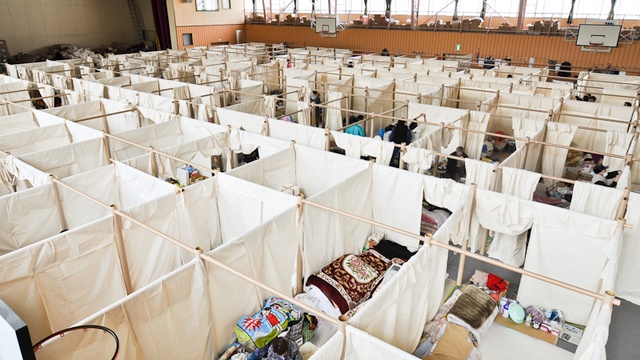
He started emphatically, stating that he does what he does now because he largely became disillusioned by the pursuit of ‘starchitect’ status (my word, not his). Early in his career, Ban embraced a humble material – cardboard – as the cornerstone of his architecture. Since then he has also morphed into an architectural philanthropist, working more and more for communities who had far less than most, and often nothing at all. He is highly sought after for his innovative architectural humanitarian work using cardboard, by organizations such as the United Nation High Commission for Refugees (UNHCR), particularly in areas destroyed by natural (and man-made) disasters.
It comes as no surprise, then, that he should pop up in earthquake-ravaged Christchurch, offering his services pro bono to aid with the reconstruction.
So, through a series of fortunate coincidences, he also appeared in Adelaide, largely on a fundraising mission for his ambitious cardboard cathedral project in Christchurch. Ban still manages to attract controversy, with some in the clergy uncomfortable with the idea of a ‘temporary’ church.
But many of Ban’s supposedly temporary projects around the world have gone on to become ‘permanent,’ as they have been embraced, cared for and maintained by the communities they gave hope to. Ironically, Ban does not consider his architecture temporary at all, taking the view that all architecture is only truly ‘permanent’ or enduring through the will of the community it serves. Hearing this, thoughts race through my head about the constant dialectic between the old and the new, which is particularly insistent for those of us in Adelaide.
Ban’s project to develop a tent from paper and cardboard with the mega manufacturing company Vitra illustrates another dialectic – between high architecture and humanitarian work. Ban proudly showed a series of photos of his prototype tent in the grounds of the Vitra Campus in Basel, Switzerland, surrounded by the work of other architectural giants including Tadao Ando, Frank Gehry, and Zaha Hadid. It is not surprising that Ban feels a stronger connection to ‘engineer’ architects like Otto and Fuller (has a foothold at the Vitra Campus) than to design celebrities.
Asked at the talk about his cultural connection to the use of paper, Ban made it clear that his use of the material is simply an economic expression, not an intellectual one. The question that brought the house down and revealed the point of Ban’s craft – or architecture, if you prefer – was when someone asked who did his engineering analysis.
The answer? He does it himself.
Jack Saunders
Shigeru Ban. In Adelaide. For a free lecture. It was almost too good to be true.
Adelaide and Christchurch celebrated forty years of sister city partnership last week (though the celebration may have been overshadowed by the arrival of Shigeru Ban. The Rennie Lecture Theatre at the University of Adelaide was crowded beyond capacity as South Australia’s architectural community welcomed the venerable architect to speak.
Practitioners, students, academics and others from across the country filled the room long before the hour-long address was scheduled to start. On his arrival, Shigeru Ban received a rock star welcome – mobbed by photographers, dignitaries and groups of excited students.
His talk was peppered with witty analogies and insight from his impressive career. He spoke against a profession driven by financial, individual gain and the influence authorities possess over a project, instead encouraging the students to realize the importance of cross-collaboration between disciplines and the impact local skills and materials can have upon a community.
He talked extensively about covering a multitude of architectural issues ranging from his admiration of Finnish architecture and carefully composed materials, evident in the work of Alvar Aalto, to drawing inspiration from architectonic objects and context.
Sharing his experiences as a student, Ban spoke about the simplicity and layering of structure, which later led to his play between temporality and permanence; challenging the monumentality of architecture. In projects such as his Picture Window house, Ban deftly blurs the distinction between internal and exterior spaces through simple, tactile solutions enhancing the occupant’s experience of landscape. Through an expressive and calming balance of logic, he reveals his architectural delight, driven by a desire to serve people with a specific need, and for me it was difficult to reconcile recent criticism of his ‘Cardboard Cathedral’ in Christchurch after hearing Ban speak.
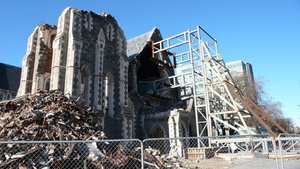
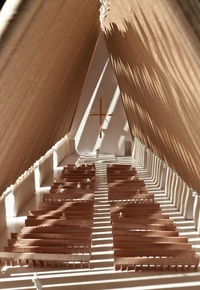
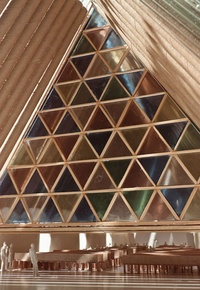
The controversial NZ$4.3 million cathedral has been designed on the site of the original 131-year-old icon – destroyed on 22 February 2011 by earthquake. Acknowledging the existing ties between the two cities, the lecture was opportunistically used as a fundraising venture for the project. The connection between Christchurch and Adelaide was established in 1972 to enhance collaboration and liaison between the cities. This union is best exemplified by the contingent of 170 staff and students from the University of Canterbury that were welcomed into the University of Adelaide to continue their study away from the devastation caused by the quakes.
Question time followed the talk with plenty of discussion about balancing practical, conceptual and graphic architecture within architectural education. When asked about his views on sustainability, Ban said he was “doing it before it was fashionable” and his unique trademark structural system, now manifests itself as “accidental environmental interest”. The architect explained that he was ‘not trying to invent anything new, he was simply utilizing what was “available and affordable”.
Perhaps the most poignant moment of the afternoon was Ban’s encouragement to students to not directly answer the ideals of bigger collectives, but to bring individuality and variety to their work, whilst considering the human aspects of creating space.
On reflection, it was more a collective experience than a lecture – and a privilege to be part of. Ban’s work embodies community and social justice, combined with three-dimensional poetry and an ingenious approach to construction. The importance of such a lecture cannot be overstated or overlooked; it will inspire and encourage what is an already bright future for South Australian design. For students who attended still in their early education the effect may be some way off, but for those nearing the end of their architectural education, the afternoon with Shigeru Ban reinforced the quest for independence, genius and soul. I have no doubt his words from that day will influence many careers, mine included.
Donations for the Christchurch appeal can be made at: cardboardcathedral or christchurchcathedral.

